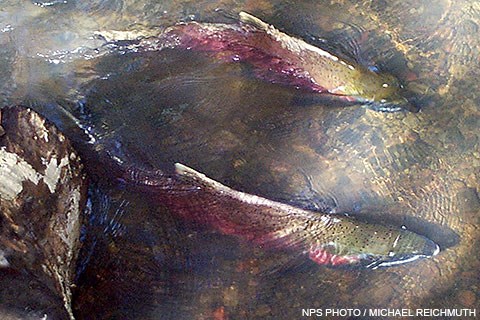
Point Reyes National Seashore protects a portion of the watershed necessary to ensure the safe migration and spawning of coho salmon (Oncorhynchus kisutch) and steelhead trout (O. mykiss). This protection is necessary as both species have been directly impacted by human activities and development. Healthy creeks are one step toward maintaining and hopefully increasing their populations. Their true hope for survival lies in changing human attitudes, behaviors, and priorities. Armed with chest waders and measuring sticks, National Park Service staff and volunteers brave streams swollen from the winter rains to survey for spawning coho and steelhead. They track spawners, carefully count carcasses, and take tissue samples for DNA analysis, providing valuable information to study the abundance and distribution of these fish. This is part of the work of the Coho and Steelhead Restoration Project. When coho salmon and steelhead trout were placed on the threatened species list, the National Park Service initiated a five-year project to identify, evaluate, restore, and enhance coho and steelhead populations and their habitat within three West Marin parks, Point Reyes National Seashore, Golden Gate National Recreation Area, and Muir Woods National Monument. The Coho and Steelhead Restoration Project is focusing on Pine Gulch, Redwood, Olema, and Lagunitas creeks and their watersheds. The project has the following six objectives:
The benefits of this program extend far beyond these salmonids. Healthy streams and riparian systems in West Marin will protect habitat for a myriad of other aquatic and land creatures such as river otters, California freshwater shrimp (an endangered species), California red-legged frogs (a threatened species), and migratory songbirds that nest in creekside bushes and shrubs. The success of this ambitious program depends on the active participation of the public, local community conservation organizations, adjacent landowners, and public agencies. By working together, we will lay the groundwork for sustainable and healthy streams, riparian zones, and watersheds. More information about Coho and Steelhead may be found on the Pacific Coast Science and Learning Center's Coho Salmon & Steelhead Trout page, along with Seasonal Updates. For information on when and where to see Coho and Steelhead, visit our Viewing Coho Salmon page. For information about becoming involved in the Coho and Steelhead Restoration Project, call project staff at 415-464-5191. The Salmon Protection And Watershed Network (SPAWN) is a local non-profit organization that works to protect endangered salmon in the Lagunitas Watershed. SPAWN offers walks to view spawning salmon for the public and for school groups, in addition to offering seminars, training, and volunteer and internship opportunities. Learn More About Coho Salmon and Steelhead TroutMultimedia PresentationsFrom 2007 to 2012, Pacific Coast Science and Learning Center Science Communication Interns produced a series of podcasts exploring science from Bay Area national parks. One of these The Natural Laboratory multimedia products is focused on coho salmon. Listen to the podcast below. Visit our Multimedia Presentations: The Natural Laboratory Audio Podcasts page for additional podcasts.
|
Last updated: September 19, 2024
